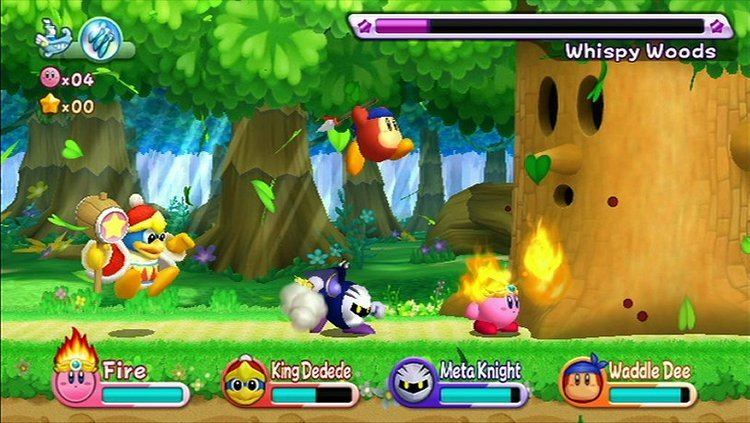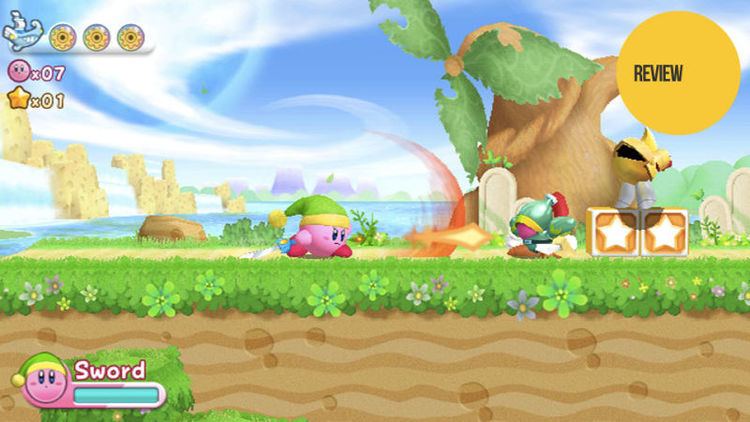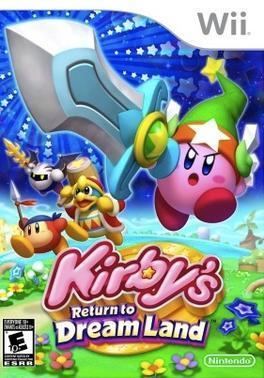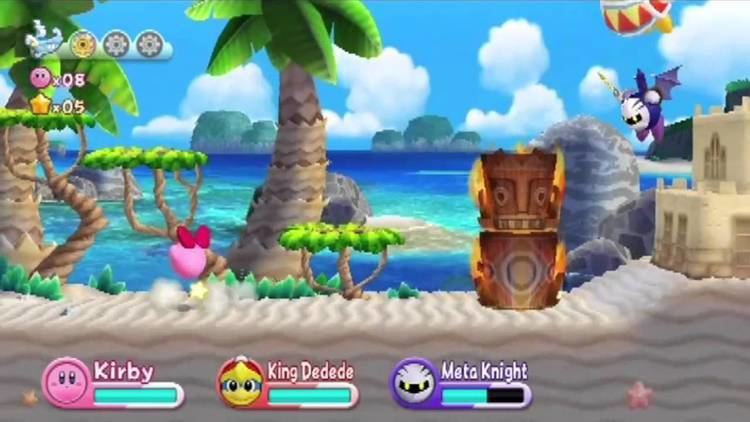8.4 /10 1 Votes8.4
7.5/10 IGN Director(s) Shinya Kumazaki Initial release date 24 October 2011 | 77% Metacritic 4.9/5 eBay Writer(s) Shinya Kumazaki | |||||||||||||||||||||||||||||||||
 | ||||||||||||||||||||||||||||||||||
Producer(s) Hiroaki SugaHitoshi YamagamiShigefumi Kawase Artist(s) Kazuyuki NakamuraKenichiro Kita Composer(s) Hirokazu AndoJun Ishikawa Similar Kirby games, Nintendo games, Platform games | ||||||||||||||||||||||||||||||||||
Kirby s return to dream land antdude
Kirby's Return to Dream Land, known in Japan as Hoshi no Kābī Wii (星のカービィWii, "Kirby of the Stars Wii") and in Europe and Australia as Kirby's Adventure Wii, is a Kirby video game and the twelfth platform installment of the series, developed by HAL Laboratory, and published by Nintendo. While Kirby's Epic Yarn was released in 2010, Kirby's Return to Dream Land is the first traditional Kirby platforming home console game since Kirby 64: The Crystal Shards, which was released in 2000 for the Nintendo 64. The title was first released in North America on October 24, 2011, and later in Europe on November 25, 2011.
Contents
- Kirby s return to dream land antdude
- Cgrundertow kirby s return to dream land for nintendo wii video game review
- Gameplay
- Plot
- Development
- Reception
- References

Kirby's Return to Dream Land features the staple gameplay of traditional Kirby platform games, in which the eponymous character Kirby possesses the ability to inhale and copy enemies in order to attain forms which give him a variety of attacks such as breathing fire or swinging a sword. The game supports cooperative multiplayer gameplay, allowing up to four players to control various Kirby characters, including Waddle Dee, King Dedede, and Meta Knight. Kirby's plot focuses on the characters retrieving the scattered pieces of a crashed alien spaceship.

The game was first announced as a Nintendo GameCube title to be released in late 2005, but development was later shifted to its successor console, the Wii. The game was presumed to be canceled until it was re-announced in 2011.

In the January 2015 Nintendo Direct, it was announced that Kirby's Return to Dream Land and other Wii games will be released for download through the Wii U's Nintendo eShop. In Japan, Kirby's Return to Dream Land was made available on January 28, 2015, and was available in Europe, Australia and New Zealand on February 19, 2015 and North America on July 30, 2015.

Cgrundertow kirby s return to dream land for nintendo wii video game review
Gameplay

Kirby's Return to Dream Land is a 2.5D side-scrolling platform game, controlled by holding the Wii Remote sideways. Differing from other games in the Kirby series, this game features a completely 2.5-dimensional style of gameplay, and 3D modeled characters, enemies, mid-bosses and bosses are used, rather than sprites like has been done since Kirby's Dreamland. The main objective is to assist the alien Magolor, whose spaceship, the Lor Starcutter, has crash-landed on Pop Star. The player is tasked with collecting the scattered pieces of the spaceship, which are dispersed and hidden within the game's levels, each of which take place in various areas of the planet.
Kirby, the main protagonist, retains his signature ability to inhale indefinitely, allowing him to suck in nearby objects and enemies. The inhaled objects can either be propelled back out as projectiles or swallowed. Certain enemies, when swallowed, allow Kirby to extract their special qualities, giving Kirby access to a wide variety of different powers, called "copy abilities." Copy abilities are used to defeat stronger enemies and clear special environmental obstacles, though Kirby can only possess one copy ability at a time. Similar to Kirby Super Star, each copy ability has multiple forms of attack that are summoned depending on the player's button-presses. New powers introduced to this game are the Whip, which lets Kirby grab out of reach items, Water, which allows Kirby to cool fiery areas, and Leaf, which lets Kirby fire leaves. By shaking the Wii Remote whilst inhaling, Kirby can perform a Super Inhale, which allows him to swallow larger enemies and blocks or multiple small ones. The game introduces more powerful, though temporary copy abilities called "Super Abilities," which are able to destroy multiple enemies at once as well as parts of the environment. Throughout the game Kirby can collect food items which recover health and earn extra lives by collection 1UP items, or by collecting 100 stars. There are also various items Kirby can use, such as keys used to unlock hidden areas, a cannon which automatically fires, a trumpet that produces a protective barrier overhead and a large boot that lets Kirby hop across enemies and spiked areas (similar to the Kuribo's Shoe in Super Mario Bros. 3). At the end of each stage, a bonus game is played in which players time a button press to jump as high as possible to earn additional items.
The game features drop-in cooperative multiplayer for up to three individual players. These players can either play as a differently colored Kirby or as one of three unique characters; Meta Knight, King Dedede, and Waddle Dee. Each of these characters possess traits from multiple Copy Abilities, though only Kirbys are able to inhale enemies and use Copy Abilities. Players are able to ride on top of each other and share health items. Unlike most multiplayer games, all players share from a pool of lives, with each player requiring one life to enter the game. If one of the three additional players loses all of their health, they can spend an extra life to rejoin the game. However, if player one dies, gameplay resumes at the last checkpoint.
Throughout the game, players can seek out Energy Spheres used to power up the Lor Starcutter, which serves as the game's hubworld. Finding these spheres often requires keen exploration, wits or skill, or the use of a specific ability or item. There are also challenging warp areas that are found whilst using Super Abilities, requiring players to escape a fast approaching black void before facing off against a miniboss to earn additional Energy Spheres. Collecting enough of these spheres unlock Challenge Rooms, which test Kirby's mastery of a specific ability, Copy Ability Rooms, which let Kirby choose Copy Abilities, and two minigames; Ninja Dojo and Scope Shot. Ninja Dojo tasks players with shaking the Wii Remote to fire ninja stars at targets whilst Scope Shot tasks players with defeating a large robot within a time limit. Clearing the game unlocks Extra Mode, a more challenging remix of the main game, and The Arena, which sees players fighting all the bosses in a random order. Clearing the Extra Mode unlocks The True Arena, where players fight the harder versions of bosses, along with three extra boss characters.
Plot
The story begins with Kirby carrying a cake, while King Dedede and Waddle Dee chase him. They run past Meta Knight, who is reading a book by a rock. Kirby and the gang sees a ship flying out of a wormhole, and they go to investigate. They enter the ship and encounter Magolor, a creature who discovers that the five vital pieces of his ship, the Lor Starcutter, along with 120 energy spheres, have been scattered across the planet. With Magolor offering them a trip to his homeworld of Halcandra should they help fix his ship, Kirby and his friends set off to recover the lost pieces of his ship. After retrieving the main pieces, they travel to Halcandra, where they are attacked by a four headed dragon named Landia. Magolor claims Landia is an evil beast that has taken over Halcandra and sends Kirby to defeat it. However, after Landia is defeated, Magolor reveals his true motive was to steal the Master Crown on its head and become all powerful, with intent of making the entire universe bow before him, beginning with Popstar. Teaming up with Landia, who is split into four dragons, Kirby and his friends confront Magolor in a final battle and manage to destroy the Master Crown, taking Magolor with it (though the Kirby's 20th anniversary collection reveals that he survived and has reformed). With peace restored to the universe, Kirby and friends are returned to Popstar whilst the Landia dragons take the Lor Starcutter and return home.
Development
Development on a new Kirby title began immediately after the release of the 2000 game Kirby 64: The Crystal Shards as a title for the Nintendo 64. The game underwent an 11-year development period in which three different proposed versions of the game were developed and then scrapped. The first build was similar to the graphical and gameplay style of Kirby 64, rendered in 3D but using traditional 2D side-scrolling gameplay. The game would also support multiplayer with up to four players. This build was demonstrated at E3 in 2005, and was set for release later that year. However, difficulty with programming four-player led to this version being scrapped. The second build placed Kirby in a 3D environment with open world-style gameplay, and the third build returned to side-scrolling gameplay but had the graphical style of a pop-up book. The development team realized that the failure of the first three attempts were caused by too much focus on multiplayer, so focus was shifted almost exclusively to the single-player experience. Development of the final version accelerated in October 2010, when the game began to take form.
Kirby's long development caused the game to frequently appear and then disappear from upcoming game lists. On September 14, 2006, the Kirby game appeared on a list of upcoming Wii games, named Hoshi no Kābī (星のカービィ, lit. "Kirby of the Stars"), set for release in Japan. The December 2006 issue of Nintendo Power removed Kirby from its list of GameCube releases, but did not place it on its list of Wii releases. Matt Casamassina of IGN, posting on his blog, furthered the idea of a Wii release by stating that it would indeed be released for the Wii in 2007. He compared it to Donkey Kong Barrel Blast, another game that was originally announced as a GameCube title, but eventually released on Wii. While the game did not appear at E3 2007, Beth Llewelyn of Nintendo of America confirmed the game "had not been abandoned." The December 2007 issue of Official Nintendo Magazine claimed that a Kirby game for Wii was not in development. On May 7, 2010, Nintendo confirmed that a Kirby Wii title was still in the making.
Nintendo announced the game Kirby's Epic Yarn at E3 2010, a completely separate title that was in development by Good-Feel. The 2005 Kirby game was then presumed to have been canceled until a Financial Results Briefing on January 28, 2011 re-announced the game with a release date set within the same year. At E3 2011, the game was demonstrated in playable form under the tentative title Kirby Wii. The game was later renamed Kirby's Return to Dream Land in North America and Kirby’s Adventure Wii in Europe, and Hoshi no Kirby Wii in Japan. The music is composed by Jun Ishikawa and Hirokazu Ando with an official soundtrack called Kirby Wii Music Selection featuring 45 musical pieces from the game.
Reception
Kirby's Return to Dream Land has received mostly positive reviews, with many praising the game's cooperative gameplay, graphics, and sounds but criticizing its lack of difficulty. Destructoid awarded the game a perfect score of 10/10, claiming, "Videogames simply do not get any more pure than Kirby's Return to Dream Land." Game Informer gave it an 8.5 out of 10, noting that, "While it doesn’t have the challenge of Donkey Kong Country Returns or the charming art style of Kirby Epic Yarn, Kirby’s Return To Dream Land is another formidable entry in a line of great side-scrolling Wii platformers." IGN was a bit less positive, giving it a score of 7.5 out of 10, criticizing the game's lack of difficulty while stating it fits perfectly for a younger audience.
